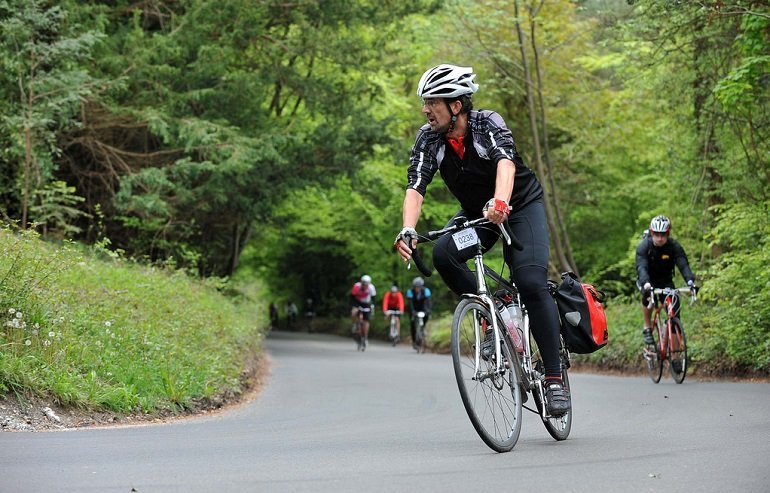Last Updated on August 11, 2022 by Editorial Staff
The phrase ‘as easy as riding a bike’ is as misguided as they come. Cycling may be an enjoyable activity, but ask any beginner, and they will have a few pleasant things to say about the scrapes and tumbles they have had to go through just to master basic bike riding skills.
Even so, there is a lot that a cyclist has to learn before they can permanently get rid of the training wheels and experience real-world cycling. Here are ten cycling skills that are absolutely essential to learn before hitting the bike trails or even the highways.
1. Shifting gears
Just like in any vehicle, the gears on your bike let you transition from high ‘sprinting’ speeds to comfortable ‘climbing’ paces, and mastering when and how to make these gear shifts can make your ride a lot smoother. Of course, everyone has their own sweet spot for pedaling, and so it is entirely up to you to determine what gears you feel most comfortable with when cycling on flat terrain.
Remember, it is much easier to shift down to easier gears when climbing hills if you do it while the incline is still shallow because this puts much less strain on the chain. Consider shifting gears down when approaching junctions too; this makes it easier to pick up the pace again once you make the turn.
2. Making big gear transitions
It is possible to jump up or down a number of gears in one shift, and this can be a handy cycling skill when you’re rapidly approaching a hill or junction. In the case of an incoming incline, you can jump from the biggest ring to the smallest in just one shift.
However, it is not advisable to shift the chain on both the front and back cassettes simultaneously as this can cause the chain to drop completely out of all sprockets. Similarly, making big shifts when the chain is not on the middle sprockets of the front cassette may lead to the same result. Keep in mind that a clean and well-oiled drivetrain will dramatically improve the speed and fluidity of your gear shifts.
3. Keeping your energy and water levels up
If you think that learning how to stay hydrated and energized while cycling isn’t a skill you need to master, you’d be wrong. You are the engine of your bike, and just like any source of power, you need fuel to keep going. Any cyclist will tell you that bonking, a phenomenon that occurs when you deplete your energy reserves while riding is not an experience you’ll enjoy.
Staying fueled for cycling requires you to stack up on carbohydrate-rich foods at least 3 hours before you ride, drinking plenty of water before and throughout the ride, and eating a protein-rich meal after your ride to speed up muscle recovery.
4. Cornering
Cornering is a skill that requires practice and your full commitment. That’s because any sudden shifts in direction or speed as you navigate a corner can unbalance you enough to send you sprawling onto the asphalt. When practicing how to corner, you should select a winding route and cycle on it as many times as you need to.

Check your speed before going into the corner, and once the road begins to bend, follow the wide curve first then lean fully into the turn as it reaches its apex. Don’t worry about straightening up afterward; the bike usually does this naturally as you exit the turn. Just be on the lookout for potholes, rocks, and other obstacles that may cause you to hesitate or worse, send you tumbling.
5. Climbing steep inclines
Love it or hate it, cycling uphill is something you will have to do at some point. The appropriate technique to use when approaching an incline will depend on the length and the duration of the incline. Shorter climbs can be tackled by using a high gear and your weight to push the pedals by standing as you cycle.
However, inclines that combine both short and long climbs require a different approach. For these, you need to start with a gear you are comfortable with then gradually lower it as the climb gets steeper. Though you can use both seated and standing pedaling techniques, seated spinning is more suited to this situation as it uses less energy, but at the cost of speed.
6. Riding downhill
This is the reason why many of us cycle: for the sheer excitement of zipping downhill with only the sound of the tires grinding against the tarmac. Descending can be very exhilarating, and some cyclists have even clocked over eighty miles per hour going downhill. That’s blisteringly fast for a cyclist, and it is also incredibly risky because one wrong move can send you to the emergency room.
The key to descending safely is to be within comfortable reach of the brake levers. Some choose hydraulic disk brakes over lever brakes because these only need a small amount of pressure to work, and can give you much more control over your descending speed. Keep your body low and relaxed, and about two fingers on each brake lever.
7. Using a heart rate monitor (HRM)
A heart rate monitor is the speedometer of your bike. You can use it to track your fitness levels as well as to keep an eye on caloric depletion (fuel reserves), and your heart rate of course. Getting the most out of your HRM revolves around the latter function.
By determining your resting heart rate and your maximum heart rate, you can easily figure out how to pace yourself for maximum endurance. Learning how to use the HRM will also teach you when your body needs to refuel as well as allow you to boost your lung capacity or even burn off some fat if that’s what you’re after.
8. Group riding
Riding in a pack takes some doing, and you shouldn’t expect to mimic the movements of the Tour de France contestants after just one day of riding a bike. Group riding requires mastery of a few essential cycling skills for the sake of safety as well as to improve the fluid movement of cyclists within the group.
Communication is very important when riding in groups, and so is consistency. Don’t make sudden turns or brake abruptly without warning the others. There are videos that can teach you the various formations riders take on when group riding. It’s best to practice group riding with friends first.
9. Proper braking
You will know that you’ve mastered braking when it becomes instinctual. Despite how easy it looks, braking is actually one of the hardest cycling skills to master. Learning how to brake doesn’t mean knowing only when to stop, but how as well.
Although a bike’s stopping power primarily comes from the front brakes, it is the rear brakes that should be engaged most of the time when a smooth stop is required. If you’ve ridden a bike before, then you probably understand the repercussions of abruptly slamming down the front brakes, which is why you should never use them when panicking.
10. Checking the rear
Bikes don’t come with rear-view mirrors, and not all of them are fitted with side-mirrors either. This is why it’s so important to look front and back before switching lanes or pulling away from a group of riders. As much as this is common etiquette for all road users, it is doubly important as a cyclist because recklessly moving from one position to another can have very dangerous results.
Conclusion
Superb riders all start from somewhere. If you’re an absolute beginner, this is as a good time as any to learn and eventually master these cycling skills to improve not just your cycling abilities, but also your safety when sharing trails with other road users. Keep in mind that a lot of these skills can only be mastered by repeated practice, and so be ready to put in the necessary hours to familiarize yourself with them. After all, the only thing that separates the great cyclists from the rest of them is experience, so practice these skills as much as you need to.
